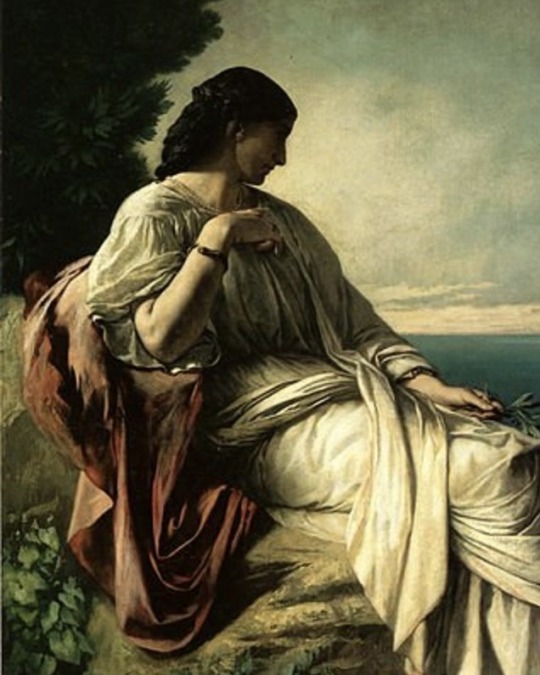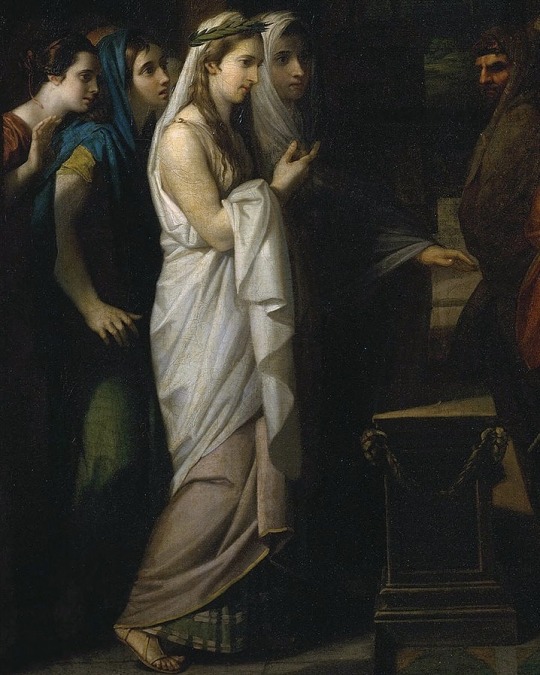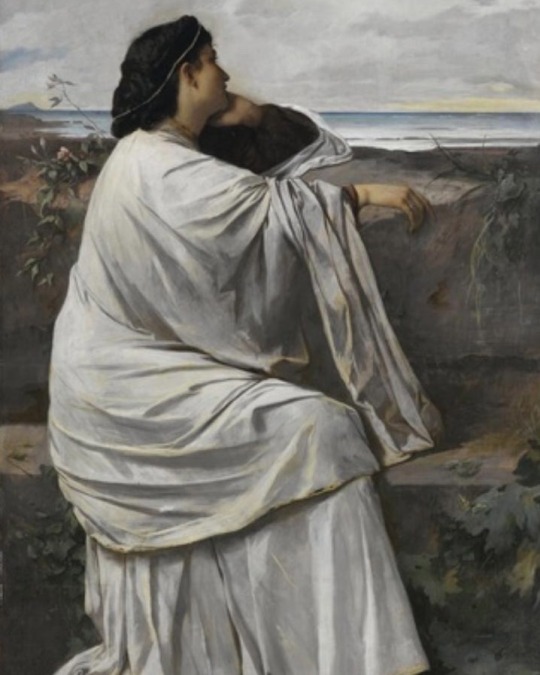#iphigeneia in tauris
Explore tagged Tumblr posts
Text








@mothercain as iphigeneia
#ethel cain#iphigenia#art#the oresteia#aeschylus#iphigeneia in tauris#greek myth#greek mythology#classics#hayden anhedönia#iphigeneia#clytemnestra#euripides
364 notes
·
View notes
Text
#tee talks#house of atreus#iphigeneia#elektra#orestes#chrysothemis#pylades#the oresteia#iphigeneia of tauris#the iliad#poll
4 notes
·
View notes
Text







You’re murdering me!
IPHIGENEIA IN TAURIS // Euripides (tr. Kenneth McLeish)
happy birthday @matressofwire ♥
#welighttheway#alicenthightowerdaily#hotdedit#otto x alicent#otto hightower#alicent hightower#game of thrones#iphigenia trusted him that’s the thing. that’s why it would have been so easy#daddy daddy what a big gun you have. how long does it take to die when you’ve been shot in the throat?#i'm sorry it's so sloppy but it's the thought that counts#the thought is suffocating tho! whatta perfect bday gift right?? <333#a love of the rack and the screw and i said i do i do#the cage is open you can walk out anytime you want why are you still in there?#shitty things i do for love#i miss them already rhys don't go
153 notes
·
View notes
Text



iphigeneia in tauris, euripides, tr. kenneth mcleish
#i feel so normal about her#fnaf#fnaf movie#fnaf movie spoilers#fnaf vanessa#vanessa afton#william afton#iphigenia
81 notes
·
View notes
Text

i didnt realize how widespread greek colonization was! all the blue stuff is greek! there's one way in the north east on the don river and way in the northwest in catalonia
According to Greek mythology, Crimea is the place to which Iphigeneia was sent after the goddess Artemis rescued her from the human sacrifice her father was about to perform. Artemis swept the young princess off to the peninsula, where she became a priestess at her temple. Here, she was forced by the Taurian king Thoas to perform human sacrifices on any foreigners who came ashore. According to other historians, the Tauri were known for their savage rituals and piracy and were also the earliest indigenous peoples of the peninsula. The land of Tauris and its rumored customs of killing Greeks are also described by Herodotus in his histories, Book IV, 99–100 and 103.
and one of the largest greek poleis was in crimea! 3000 square kilometers!
104 notes
·
View notes
Quote
There is much confusion in the workings of the gods as there is among mortals: only one thing hurts, when one who has good sense has listened to the words of prophets and is ruined, as the wise men know.
Iphigeneia in Tauris by Euripides
26 notes
·
View notes
Text
i have this natural gift and it’s called “my poems i write without reading a connected piece of literature to the thing it’s based on have a weird way of being almost exactly like that despite me never having read it.”
1 note
·
View note
Photo

Roman fresco from the triclinium in the Casa del Centenario (IX 8,3-6) Pompeii , Campania, Italy.
Scene from the tragedy Iphigenia in Tauris by Euripides. In the center Orestes, on the left Pylades, on the right Iphigeneia.
Author: Wolfgang Rieger (CC0)
249 notes
·
View notes
Note
hi! sorry you probably get this kinda ask a hundred times a month but i wanted to check! i wanna get into tragedies and greek classics! i saw the names emily wilson and caroline alexander come up a couple times in your faq. could you rec me popular/loved translations of the plays? for medea, antigone, iphigenia, elektra, agamemnon, the oresteia? any other tragedy that i forgot to add to this is welcomed too! thank you, sorry for the bother
hi! im less interested in tragedy than epic and so am Way less fussy about particular translations (than i maybe should be) like you can probably just read whatever you can get your hands on. that said! i do recommend the greek plays edited by mary lefkowitz and james romm which has translations by a variety of translators of all the plays you mentioned Except either iphigeneia play. anne carson has a translation of iphigeneia at tauris + her grief lessons (assorted euripides) is cool and sexy. seamus heaney's translations of antigone (the burial at thebes) and philoctetes (the cure at troy) are also v good. hope you found this useful :-)
20 notes
·
View notes
Photo

A scene from Euripides’ Iphigenia in Tauris, showing Orestes between Pylades and Iphigeneia. Fresco from the triclinium of the procurator in the Casa del Centenario, Pompeii.
#classics#tagamemnon#Ancient Rome#Roman Empire#Pompeii#Greek tragedy#Attic tragedy#Euripides#Iphigenia in Tauris#art#art history#ancient art#Roman art#Ancient Roman art#Roman Imperial art#fresco#Casa del Centenario
645 notes
·
View notes
Text
god if we’re talking about greek mythology/vg parallels....
what about orestes and pylades? i know some mfer has probably stuck the quote from euripides’ ‘iphigeneia in tauris’ (translated by anne carson) into one of their ww posts but there is so much more. (quote is right below)

these words say so much. this? this is the quote that says “i love you more than either of us can ever understand. i choose to take care of you. i choose to stay, here, with you.” if i left it at that, it would already say so much. but there’s more.
orestes and pylades were synonymous with love and loyalty. they had been friends and companions from the very time of their birth and remained so all throughout their lives. they took a god of love to act as witness of the passion between them. i mean. that’s homoeroticism right there.
pylades would follow orestes to the ends of the earth. pylades would stay with orestes if it meant death. pylades would die for orestes.
but orestes—beloved orestes—ultimately chooses to die for pylades instead. one of them must be slain as a sacrifice to artemis. iphigenia, priestess of artemis and orestes’ sister, offers orestes an alternative. he can go deliver a letter for her, and live. pyrades will be slain instead.
and orestes refuses, because of course he would. of course orestes would choose pylades’ life over his own. both of them wish to remain to save the life of the other.
it’s about choosing to stay with the other person
(anything for you, valdez. / not to me. not if it’s you.).
choosing their partner’s life over their own
(to storm or fire / to pylades or orestes)
as lucian says in his ‘erotes’: “[when the] long-loved object returns reciprocal affection, [it] is hard to determine which the lover of which, for – as from a mirror – the affection of the lover is reflected from the beloved.”
#orestes and pylades#valgrace#valgrace analysis#leo valdez#jason grace#my brain is soup#but gay soup#also it's running on cold meds#so ha yeah
102 notes
·
View notes
Text
The Worship of Taurian Artemis and Iphigeneia
I wanted to write this post because I worship Iphigeneia and I think it is kinda neat. There is a connection between Artemis as she was worshipped in Tauris and Iphigeneia. Iphigeneia may have been syncretized with Artemis and the goddess who was worshipped in Tauris. Artemis has a few epithets that are related to Iphigeneia.
“O′RTHIA (Orthia, Orthias, or Orthôsia) a surname of the Artemis who is also called Iphigeneia or Lygodesma, and must be regarded as the goddess of the moon. Her worship was probably brought to Sparta from Lemnos. It was at the altar of Artemis Orthia that Spartan boys had to undergo the diamastigosis (Schol. ad Pind. Ol. iii. 54 ; Herod. iv. 87; Xenoph. de Rep. Lac. ii. 10). She also had temples at Brauron, in the Cerameicus at Athens, in Elis, and on the coast of Byzantium. The ancients derived her surname from mount Orthosium or Orthium in Arcadia.” (Theoi.com-Artemis Cult titles and epithets)
“TAU′RICA (DEA) (hê Taurikê), "the Taurian goddess," commonly called Artemis. Her image was believed to have been carried from Tauris by Orestes and Iphigenia, and to have been conveyed to Brauron, Sparta, or Aricia. The worship of this Taurian goddess, who was identified with Artemis and Iphigenia, was carried on with orgiastic rites and human sacrifices, and seems to have been very ancient in Greece. (Paus. iii. 16. § 6; Herod. iv. 103.) (Theoi.com-Artemis Cult titles and epithets)
“TAURIO′NE, TAURO, TAURO��POLOS, or TAURO′POS (Tauriônê, Taurô, Tauropolo, Taurôpos), originally a designation of the Taurian goddess, but also used as a surname of Artemis or even Athena, both of whom were identified with the Taurian goddess. (Hesych. s. v. tauropolai.) The name has been explained in different ways, some supposing that it means the goddess worshipped in Tauris, going around (i. e. protecting) the country of Tauris, or the goddess to whom bulls are sacrificed; while others explain it to mean the goddess riding on bulls, drawn by bulls, or killing bulls. Both explanations seem to have one thing in common, namely, that the bull was probably the ancient symbol of the bloody and savage worship of the Taurian divinity. (Schol. ad Soph. Ajac. 172 ; Eurip. Iphig. Taur. 1457 ; Müller, Orchom. p. 305, &c. 2d ed.)”(Theoi.com-Artemis Cult titles and epithets)
Iphigenia is also mentioned alongside Artemis and the Taurian goddess in Herodotus’ Histories and Pausanias’ description of Greece. This shows that Iphigeneia was worshipped but was also syncretized with Artemis which is interesting.
“Among these, the Tauri have the following customs: all ship-wrecked men, and any Greeks whom they capture in their sea-raids, they sacrifice to the Virgin goddess1 as I will describe: after the first rites of sacrifice, they strike the victim on the head with a club; [2] according to some, they then place the head on a pole and throw the body off the cliff on which their temple stands; others agree as to the head, but say that the body is buried, not thrown off the cliff. The Tauri themselves say that this deity to whom they sacrifice is Agamemnon's daughter Iphigenia. [3] As for enemies whom they defeat, each cuts his enemy's head off and carries it away to his house, where he places it on a tall pole and stands it high above the dwelling, above the smoke-vent for the most part. These heads, they say, are set up to guard the whole house. The Tauri live by plundering and war.” (Herodotus Book 4 chapter 103)
“Pausanias has left us two sources that identify Artemis with Iphigenia: in one of them he mentions a temple of Artemis at Hermione in Argolis where this goddess is called Iphigenia (Paus. II, 35, 1), i.e. testifies of a cult of Artemis-Iphigenia; in the other – a temple of Artemis with a statue of Iphigenia in Aigira, Achaea, which according to the explanation of the periegetes meant that in ancient times the temple had been dedicated to Iphigenia” (Paus. VII. 26. 5).” (The Cult of Artemis-Iphigenia,Ruja Popova 59) “[7.26.5] There is also a temple of Artemis, with an image of the modern style of workmanship. The priestess is a maiden, who holds office until she reaches the age to marry. There stands here too an ancient image, which the folk of Aegeira say is Iphigeneia, the daughter of Agamemnon. If they are correct, it is plain that the temple must have been built originally for Iphigeneia.” (Pausanias 7.26.5)
“Near the latter is a temple of Dionysus of the Black Goatskin. In his honor every year they hold a competition in music, and they offer prizes for swimming-races and boat-races. There is also a sanctuary of Artemis surnamed Iphigenia, and a bronze Poseidon with one foot upon a dolphin. Passing by this into the sanctuary of Hestia, we see no image, but only an altar, and they sacrifice to Hestia upon it.” (Pausanias 2.35.1)
“They say that there is also a shrine of the heroine Iphigenia; for she too according to them died in Megara. Now I have heard another account of Iphigenia that is given by Arcadians and I know that Hesiod, in his poem A Catalogue of Women, says that Iphigenia did not die, but by the will of Artemis is Hecate. With this agrees the account of Herodotus, that the Tauri near Scythia sacrifice castaways to a maiden who they say is Iphigenia, the daughter of Agamemnon. Adrastus also is honored among the Megarians, who say that he too died among them when he was leading back his army after taking Thebes, and that his death was caused by old age and the fate of Aegialeus. A sanctuary of Artemis was made by Agamemnon when he came to persuade Calchas, who dwelt in Megara, to accompany him to Troy.” (Pausanias 1.43.1) “Four ideas must be kept in mind when considering this conundrum. The first is that Herodotos did travel to the Crimea personally, and thus he was a first-hand observer of this aspect of Tauric religion. Second, the historian specifies that it is the Tauroi themselves who make this claim, not Greeks who attribute this identity to a foreign deity. Third, it is obvious that both the word “Parthenos” and the name Iphigeneia are Greek, meaning that the indigenous Tauroi were clearly sufficiently influenced by their Greek neighbors by the fifth century at the latest to have adopted a foreign identification for their own goddess. Fourth, we have virtually no indigenous evidence about Tauric religion, and thus we are unable to see the native divinity behind the Greek overlay.” (Gods and Heroes: Artemis, 123)
I think that the author here raises a good question about the quotes in Herodotus’ Histories regarding Iphigeneia in Tauris, and we don’t really have an answer yet. But what is in Herodotus’ Histories combined with Iphigeneia being mentioned more than once in Pausanias’ description of Greece shows that she was worshipped even in Greece.
Bibliography
"Artemis Titles And Epithets". Theoi.Com, 2000, https://www.theoi.com/Cult/ArtemisTitles.html. Accessed 18 Jan 2021.
"Herodotus, The Histories,Book 4, Chapter 103". Perseus.Tufts.Edu, 2021, http://www.perseus.tufts.edu/hopper/text?doc=Perseus:text:1999.01.0126:book=4:chapter=103. Accessed 18 Jan 2021.
"Pausanias, Description Of Greece,Achaia, Chapter 26, Section 5". Perseus.Tufts.Edu, 2021, http://www.perseus.tufts.edu/hopper/text?doc=Paus.+7.26.5&fromdoc=Perseus%3Atext%3A1999.01.0160. Accessed 18 Jan 2021.
"Pausanias, Description Of Greece,Attica, Chapter 43, Section 1". Perseus.Tufts.Edu, 2021, http://www.perseus.tufts.edu/hopper/text?doc=Paus.+1.43.1. Accessed 18 Jan 2021.
"Pausanias, Description Of Greece,Corinth, Chapter 35, Section 1". Perseus.Tufts.Edu, 2021, http://www.perseus.tufts.edu/hopper/text?doc=Paus.+2.35.1&fromdoc=Perseus%3Atext%3A1999.01.0160. Accessed 18 Jan 2021.
Budin, Stephanie. Gods And Heroes-Artemis. Routledge, 2016, p. 123.
Popova, Ruja. "The Cult Of Artemis-Iphigenia In The Tauric Chersonesus: The Movement Of An Aition". Orpheus Journal Of Indo European And Thracian Studies, vol 18, 2011, p. 59., Accessed 18 Jan 2021.
29 notes
·
View notes
Photo

mythology aesthetics
THOAS
In Greek mythology, Thoas was a son of the god Dionysus and Ariadne. Rhadamanthus, Ariadne's uncle, bequeathed Thoas the island of Lemnos, over which he reigned until the women of the island slaughtered all the other men. His daughter Hypsipyle tied him secretly in an oarless boat and sent him adrift into the Aegean Sea. Thoas eventually arrived at Tauris, in the Crimea, where he was made king and where Artemis installed Agamemnon's daughter Iphigeneia as her temple's priestess. Thoas was eventually killed during the Trojan War by Chryses.
35 notes
·
View notes
Quote
Where do you come from, O unhappy travellers? You have sailed a great distance in order to reach this land, and far, far from home, must spend eternity below.
Iphigeneia in Tauris by Euripides
72 notes
·
View notes
Photo

Ifigenia în Taurida a lui Euripide | Tragedie sau melodramă?
Piesa de teatru "Ifigenia în Taurida" (în grecește "Iphigeneia en Taurois") este o tragedie, deși uneori este descrisă ca o melodramă, a scriitorului antic grec Euripide, scrisă cândva între anii 424 î.Hr. și 412 î.Hr. Ea înfățișează șansa reînt��lnirii Ifigeniei (fiica lui Agamemnon, ajunsă preoteasă a zeiței Artemis pe malurile sălbatice din Taurida / Tauris) cu Oreste, fratele ei pierdut de mult timp și reușita celor doi de a scăpa de sacrificiul ritual de pe acele meleaguri. Povestea este o urmare a celei din piesa "Ifigenia în Aulide" a lui Euripide, cu 20 de ani mai înainte, deși a fost scrisă, de fapt, cu șapte ani mai târziu. https://www.diane.ro/2022/06/ifigenia-in-taurida-lui-euripide.html
0 notes
Text
The brave will dare the effort (of war), cowards are nothing nowhere.
- Euripides, Iphigeneia in Tauris
1 note
·
View note